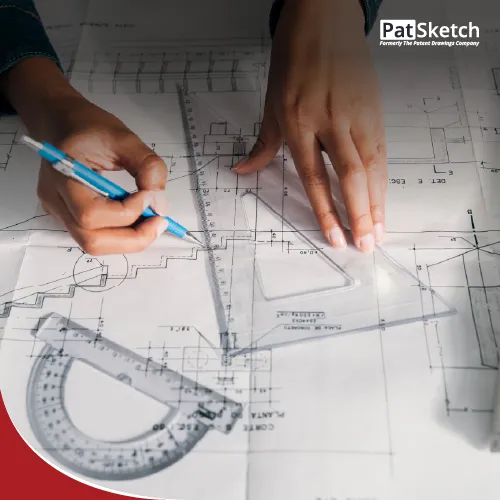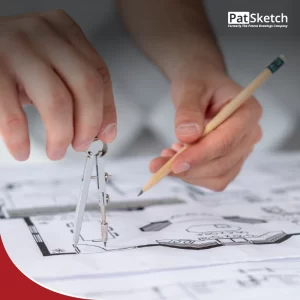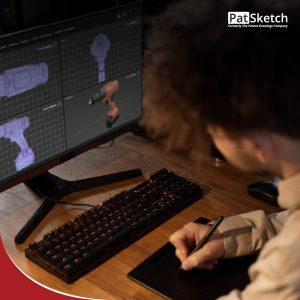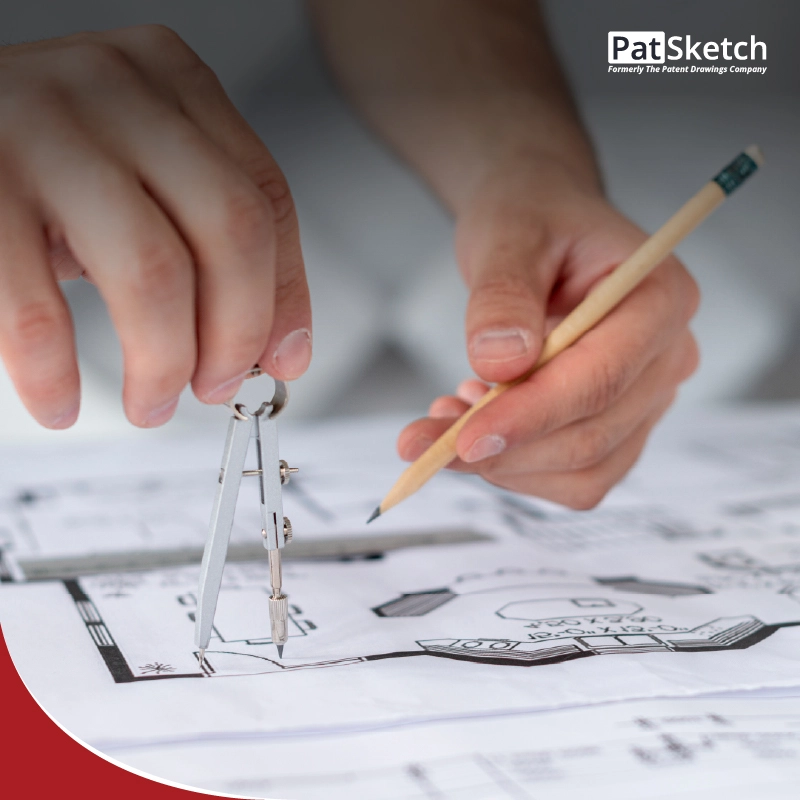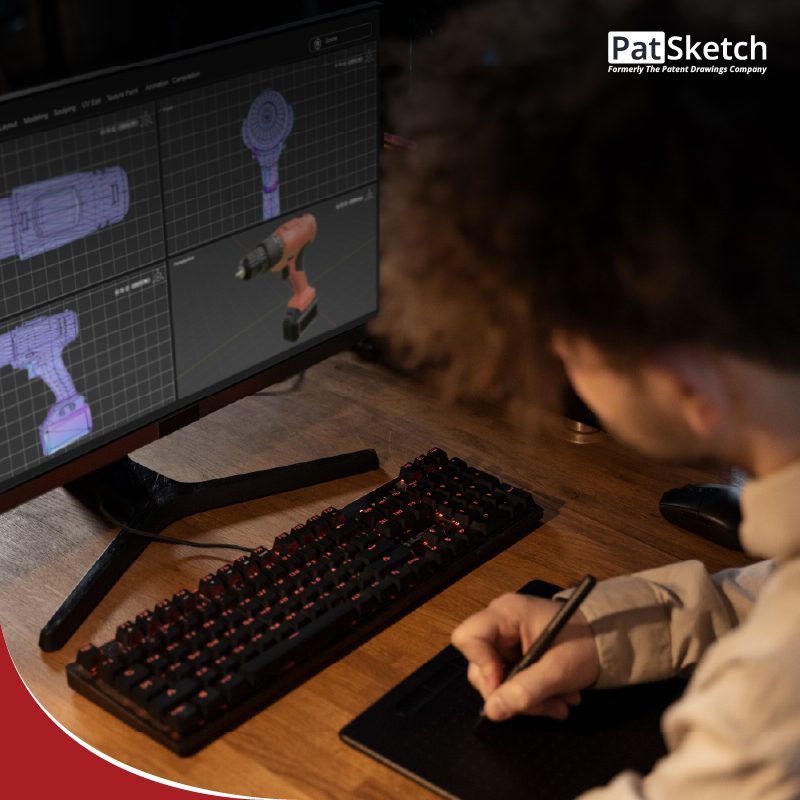Patent illustrations are a cornerstone of any successful patent application. They do more than complement the written description, they visually communicate how an invention looks and functions. Patent offices such as the USPTO, EPO, and WIPO require multiple views of patent drawings to ensure that every aspect of an invention is represented accurately.
In this article, we explore the most important types of views in patent illustration, their unique purposes, and how they strengthen a patent application.
Also read: Methods of Creating Patent Drawings
Views of Patent Illustration
1. Isometric View
An isometric view is a three-dimensional representation of an invention where the length, width, and height are displayed in a single image. Unlike perspective drawings, the angles remain proportional, avoiding distortion. Typically, isometric projections are drawn with axes at 120° from each other, ensuring all dimensions are to scale.
Purpose:
- Provides a complete overall picture of the invention.
- Makes it easy for examiners and third parties to understand the invention at a glance.
- Reduces confusion by showing the invention in its natural 3D form.
Use Case Example: A consumer gadget like a smartphone can be best understood through an isometric view, as it instantly shows its overall shape and design.
2. Orthogonal (Orthographic) View
Orthogonal views, commonly known as front, top, and side views, are flat projections of the invention. These are the most precise views, showing true dimensions without distortion. Each side is drawn at right angles, giving an exact proportional representation.
Purpose:
- Provides examiners with accurate measurements and dimensions.
- Complements the isometric view by showing exact proportions of each side.
- Ensures compliance with patent office requirements, which often mandate orthogonal views.
Use Case Example: For a mechanical device like an engine component, orthogonal views clearly demonstrate size, symmetry, and shape, which are critical for patent approval.
3. Sectional View
A sectional view slices through the invention to reveal internal features that would otherwise remain hidden. These drawings often use cross-hatching or shading to indicate cut surfaces and material types.
Purpose:
- Shows internal construction, layers, or hidden mechanical parts.
- Essential when the invention’s functionality depends on interior design.
- Helps eliminate ambiguity for examiners by exposing critical internal details.
Use Case Example: In medical devices, a sectional view of a syringe mechanism could reveal how its internal spring and needle housing operate.
4. Exploded View
An exploded view illustrates how individual parts of an invention fit together, while still showing their relative positions. The components are separated but aligned to indicate their assembly order.
Purpose:
- Demonstrates the relationship and interaction between parts.
- Useful for complex devices with multiple components.
- Enhances understanding of how the invention is assembled and functions.
Use Case Example: For an automobile gearbox, an exploded view highlights gears, shafts, and housing separately, helping examiners see how parts combine to form the whole system.
5. Perspective View
A perspective view mimics how the human eye perceives an object. Unlike orthogonal views, perspective drawings show objects receding into space, making them look more realistic. However, because they can distort actual proportions, some patent offices treat them as supplementary rather than mandatory.
Purpose:
- Adds realism to the representation of the invention.
- Helps non-technical audiences, such as investors or stakeholders, visualize the invention.
- Often used for marketing and presentations.
Use Case Example: A new chair design can be shown in perspective view to highlight its aesthetic appeal while maintaining a realistic sense of scale.
6. Plain or Unornamented View
When the invention is flat, simple, or without complex details, a plain view is used. These drawings do not use unnecessary shading, textures, or embellishments—just simple line work that conveys the object clearly.
Purpose:
- Avoids redundancy when the object has no depth or hidden details.
- Keeps the drawings neat and compliant with patent office requirements.
Use Case Example: A flat panel, a sheet of glass, or a surface covering can be effectively shown with a plain, unornamented view.
7. Detail or Enlarged View
A detailed view magnifies specific areas of an invention that are too small to be seen clearly in the main drawings. These views are often circled or referenced from the main figure and then enlarged separately.
Purpose:
- Highlights intricate features such as grooves, fasteners, or small mechanisms.
- Ensures no critical part of the invention is overlooked or misunderstood.
- Adds credibility to the application by showing attention to detail.
Use Case Example: In a wristwatch patent, a detail view can enlarge the clasp mechanism, ensuring examiners understand its unique functionality.
Also read: Qualities of a Good Patent Drawings Company
Why Multiple Views Matter in Patent Illustrations
- Compliance with Regulations: Patent offices require multiple views to ensure the invention is fully disclosed.
- Clarity for Examiners: Each view highlights different aspects, preventing misinterpretation.
- Legal Strength: Detailed drawings reduce the risk of disputes and strengthen enforceability.
- International Acceptance: Offices like USPTO, EPO, and WIPO have strict standards that multiple views help satisfy.
Quick Checklist for Patent Drawings
- Always include isometric or perspective views for clarity.
- Provide orthogonal views to show exact dimensions.
- Add sectional and exploded views for internal and assembly details.
- Use detail views for small or intricate parts.
- Ensure compliance with patent office guidelines (line thickness, margins, numbering).
Conclusion
It is very important to add patent illustrations in the patent application, and adding all possible views of the invention is also very important. Different views of patent drawings help the patent examiner to understand the invention more closely and clearly. So, it is very important to make full use of the patent drawings by adding as many views as required to represent a clear picture of the invention to get a step closer to getting patent approval.
PatSketch for Patent Drawing Services
Ensure your PCT application meets WIPO’s strict patent drawing rules. Whether you need utility patent drawings or design patent drawings, following these standards is essential for the success of your patent application. PatSketch offers expert services, adhering to all necessary guidelines for precise and compliant patent drawings, ensuring your application is clear, accurate, and ready for approval.
Related articles:

